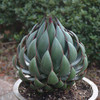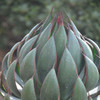Product Description
Mangave 'Praying Hands' PP34508 - MAD ABOUT MANGAVE Collection (72)ct Flat
Common Name: Mangave
A brand new and totally different look than what you've seen in Mangave so far! Dark green leaves stay curled upward like a teardrop or an artichoke, where the cinnamon brown terminal spines nearly touch each other. 'Praying Hands' gets its unique habit from one its parents, Agave ocahui.
Mangave is a relatively new phenomenon, an intergeneric cross of Manfreda x Agave. These rare hybrids combine the best of both worlds: the better growth rate and the interesting patterns of Manfreda, and the habit and refinement of Agave. We are very excited (shall we say mad?) about our new hybrids from Walters Gardens hybridizing.
Mangave is a tender perennial or "temperennial" succulent plant that grows best in full sun. Plant in well-drained, dry to average soil in containers just slightly wider than the width of the rosette or plant directly in the ground. In summer when the plants are actively growing, they appreciate a bit of supplemental watering and half-strength fertilizer. They should be grown dry in winter. Mangave is a slower grower, so it will not quickly overtake the space it is allotted in the landscape.
Height: 8.0-10.0 Inches
Spread: 8.0-10.0 Inches
Hardiness Zones: 9,10,11
Foliage Color: Blue shades
Full Sun (> 6 hrs. Direct Sun)
Low Water Needs
Poor to Average Soil Quality
Deer and Rabbit Resistant
Growth Rate: Slow
Container, Drought Tolerant, Attractive Foliage, Small, Specimen, Focal Point, Native to North America
Mangave 'Praying Hands' is a truly unique and captivating succulent that's been making waves in the gardening world. It is a hybrid, a cross between Manfreda and Agave, and it brings together some of the best traits of both parents. Here is what makes it so special:
What Makes Mangave 'Praying Hands' Special
- Unique Form: The most striking feature of 'Praying Hands' is its unusual form. The tightly packed, upright leaves curl inwards, creating a shape that resembles clasped hands in prayer or an artichoke. This distinctive form adds a sculptural element to gardens and makes it a real conversation starter.
- Interesting Colors and Texture: The leaves are a beautiful silvery-blue to dark green color with a subtle, waxy texture. They are also adorned with cinnamon brown terminal spines, adding to the visual interest.
- Compact Size: 'Praying Hands' is a relatively compact mangave, typically reaching about 8-10 inches tall and wide. This makes it a great choice for smaller gardens, rock gardens, or containers.
- Fast-Growing: Compared to many agaves, mangaves are known for their faster growth rate. 'Praying Hands' will quickly fill out its space and provide a bold presence in the garden.
- Hardy and Adaptable: It is hardy in USDA Zones 9-11 and can tolerate a range of conditions, from full sun to light shade and well-drained soil.
Description and Details
- Common Name: Praying Hands Mangave
- Botanical Name: Mangave 'Praying Hands'
- Mature Size: 8-10 inches tall and wide
- Foliage: Silvery-blue to dark green, upright, curled leaves with cinnamon brown terminal spines
- Flowers: Although it can flower, it rarely does in cultivation. The focus is on the foliage.
- Growth Habit: Compact, rosette-forming
- Hardiness Zones: 9-11
- Light: Full sun to light shade
- Soil: Well-drained soil
- Water: Drought-tolerant once established
Landscaping Design Tips
- Specimen Plant: Its unique form and color make it an excellent specimen plant, where it can be the focal point of a garden bed or container.
- Xeriscaping: It is a perfect choice for xeriscaping or drought-tolerant gardens, as it requires minimal water once established.
- Rock Gardens: It is also a good choice for rock gardens, where its architectural form and texture can complement the rocks and other succulents.
- Containers: It is well-suited for containers, adding a bold statement to patios and balconies.
- Companion Plants: Consider pairing them with other drought-tolerant plants that offer contrasting colors and textures, such as:
- Other Mangaves and Agaves
- Yuccas
- Sedums
- Grasses
- Salvias
Planting and Care
- Planting:
- Choose a sunny location with well-drained soil.
- Plant in spring or fall.
- Dig a hole twice as wide as the root ball and just as deep.
- Place the plant in the hole and backfill with soil, making sure the crown is level with the surrounding ground.
- Water thoroughly after planting.
- Care:
- Water deeply but infrequently, allowing the soil to dry out completely between waterings.
- Avoid overwatering, as this can lead to root rot.
- No fertilization is needed.
- Remove any dead or damaged leaves.
- Protect from frost in colder climates.
Additional Notes
- 'Praying Hands' is a relatively new mangave variety that has quickly gained popularity for its unique form and easy care.
- It is a great choice for gardeners looking for a low-maintenance, drought-tolerant plant that adds a touch of the exotic to the landscape.
- It was awarded the Best Plant at the International Plant Fair (IPM) Essen in 2024.
Other Details
The most important part of the plant is its root system. Healthy roots are the foundation of a healthy, vibrant plant. The type of plug container used is based on the specific needs of the plants. Perennials offered as bare root traditionally perform better when planted as bare root.Planted in a specialized mix, potted plants have well established root systems. Top growth stage will vary depending on the current life cycle and time of year when shipped. In Winter and early Spring dormant plants may be shipped. Dormant plants may be planted right away, even before the last frost date.
Most bare root varieties are field grown for at least one season, though Hemerocallis and Hosta are grown for two seasons. The bulk of the soil is removed during the harvesting process and the tops of most varieties are trimmed back to the crown. They are graded, packed in shredded aspen or sphagnum moss and stored in freezers until ready to be shipped.
See our Container Sizes and Bare Root Perennials pages for more information.
Plant information and care is provided in the Overview section, Plant Genus Page and general information is provided in the Planting Care & Guides. Additional questions can be asked on each Plant page.
Plant Spacing: Using the maximum mature spread or width of a plant to guide spacing, ensures space to grow to full size. To fill an area sooner, plant them closer together. Just remember, future thinning or transplanting may be needed.
Water: Keep a close eye on newly planted perennials, especially throughout the first growing year. Most early plant loss is due to too much or too little water!










